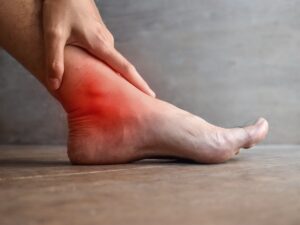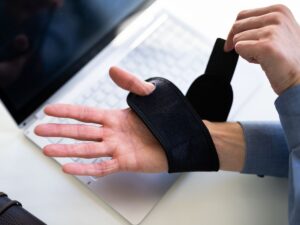Understanding Plantar Fasciitis and Heel Pain
Plantar fasciitis is one of the most common causes of persistent heel pain, affecting individuals of varying ages and activity levels. The condition arises when the plantar fascia—a thick band of tissue running from your heel bone to your toes—becomes inflamed or irritated. This inflammation often manifests as a sharp or stabbing pain in the bottom of the foot, particularly near the heel, and can be most pronounced upon waking or after prolonged periods of sitting. Everyday activities like standing, walking, or exercising then become increasingly difficult, potentially leading to additional discomfort in the ankles, knees, and hips if not adequately treated. Fortunately, a combination of targeted therapies, consistent stretching, and mindful lifestyle changes can significantly ease symptoms and pave the way for lasting relief. If you’re exploring ways to eliminate heel pain, our Heel Pain Relief for Plantar Fasciitis resource offers comprehensive insights tailored to your specific needs.
Key Symptoms and Risk Factors
Plantar fasciitis is generally characterized by a burning, stabbing, or aching pain near the heel—often worse in the morning or after long periods of rest. While anyone can develop plantar fasciitis, certain risk factors increase susceptibility:
- High-Impact Activities: Runners, dancers, and people who engage in sports involving jumping or sudden shifts in weight.
- Obesity: Excess body weight adds stress to the plantar fascia, contributing to microtears and persistent inflammation.
- Prolonged Standing: Occupations that demand standing for lengthy intervals—like teachers or factory workers—can strain the foot’s arch.
- Foot Structure: Flat feet, high arches, or an abnormal gait can shift pressure onto the plantar fascia.
- Unsupportive Footwear: Shoes lacking adequate arch support or cushion can exacerbate tissue irritation and hamper recovery.
Identifying these factors plays a pivotal role in designing an effective treatment plan. For instance, addressing weight management or switching to supportive shoes can diminish daily strain on the fascia, facilitating faster healing.
Conservative Measures for Initial Relief
When heel pain first emerges, conservative treatments often prove highly effective. Simple steps like resting the foot, applying ice to reduce inflammation, and using over-the-counter anti-inflammatory drugs may bring short-term relief. Orthotic inserts or insoles specifically designed to support the arch can also limit stress on the plantar fascia, making daily movements more comfortable. Avoiding high-impact workouts in favor of low-impact options—like swimming, cycling, or elliptical training—can be another strategic modification, preventing further irritation. Combining these at-home strategies with a supervised exercise regimen usually yields the best outcomes, especially when foot and ankle alignment issues underlie the pain.
Targeted Stretching and Strengthening
One of the central pillars of plantar fasciitis treatment is rehabilitative exercise aimed at elongating and fortifying the plantar fascia, Achilles tendon, and surrounding muscles. Common stretches and drills include:
- Calf Stretch Against the Wall: Stand facing a wall, place one foot behind you, and gently press the heel to the ground. This maneuver targets tight calf muscles that can tug on the plantar fascia.
- Seated Foot Flexes: While seated, point and flex the toes to warm up the arch of the foot, improving blood flow and relieving tension.
- Heel Raises: Standing with feet shoulder-width apart, rise onto the balls of your feet, pause, then lower slowly to build calf and arch strength.
- Towel Grabs: Spread a small towel on the floor, using your toes to scrunch and pick it up. This exercise boosts the smaller stabilizing muscles in the foot.
- Frozen Water Bottle Roll: Place a frozen water bottle under your foot, rolling it from heel to toe for both massage and inflammation reduction.
Consistently executing these stretches multiple times a day accelerates recovery by maintaining flexibility and blood circulation. Over time, you’ll likely notice a decline in morning stiffness and an ability to walk longer distances without pain.
The Role of Professional Therapy
While DIY measures can go a long way, persistent or intense heel pain may necessitate professional intervention. Physical therapists usually start with a thorough assessment of foot mechanics, ankle strength, and any postural imbalances. Their therapeutic toolkit may include manual therapy to ease tight muscles, tailored resistance exercises to stabilize the arch, and taping or bracing techniques to limit abrupt strain on the plantar fascia. Complementary modalities—like ultrasound or electrical stimulation—can also be used to decrease inflammation. By systematically blending these elements, professionals create an individualized plan to strengthen your foot and ankle, ensuring you can resume normal activities without recurring pain.
Chiropractic Alignment with Dr. Elham
Dr. Elham brings a holistic approach to relieving plantar fasciitis, focusing on correcting biomechanical imbalances and ensuring proper spinal alignment. Although the pain is localized in the heel, misalignments higher up—like a tilted pelvis or poor lower back posture—can funnel excessive stress down to the feet. By incorporating gentle adjustments and realigning the body, Dr. Elham helps redistribute weight more evenly across the legs and feet, relieving pressure on the plantar fascia. Additionally, she may recommend at-home exercises, shoe modifications, and nutritional advice that support recovery. For individuals who’ve tried standard protocols with limited success, Dr. Elham’s integrative style offers an alternative pathway toward sustainable relief.
Night Splints and Orthotic Supports
Many sufferers of plantar fasciitis experience acute pain first thing in the morning because the plantar fascia tightens overnight. A night splint—which keeps the foot dorsiflexed—can mitigate that stiffness by maintaining a gentle stretch throughout your sleep. Although it may take some adaptation, consistent use often leads to easier, less painful mornings. Meanwhile, orthotic arch supports or custom-fitted shoe inserts help guide weight distribution during the day, diminishing strain on the heel. These solutions are especially beneficial for those with extreme arch variations or for workers who stand for extended periods. Pairing night splints with daytime orthotics sets up a round-the-clock protective environment for healing tissues.
Addressing Chronic Inflammation
Persistent heel pain sometimes indicates deeper inflammation requiring more targeted interventions. In such cases, doctors might suggest corticosteroid injections around the plantar fascia to deliver anti-inflammatory medication directly to the affected tissues. While these injections can offer swift symptom relief, they’re generally used sparingly due to potential side effects, such as tissue weakening at the injection site. Newer techniques—like platelet-rich plasma (PRP) injections—harness the body’s healing factors to reduce chronic inflammation and encourage tissue repair. Combining these methods with physical therapy and other conservative strategies often yields the best long-term outcome, minimizing the chance of recurring pain.
Shockwave Therapy and Other Advanced Modalities
For stubborn plantar fasciitis that resists standard treatment, certain specialized procedures may be considered. Extracorporeal shockwave therapy (ESWT) administers high-energy sound waves to the heel area, stimulating cellular metabolism and circulation. This can promote tissue regeneration and reduce pain over a series of sessions. Some clinics also use radiofrequency ablation or laser therapy for a similar effect. While these interventions can be highly effective, they might come with higher costs or availability constraints, so evaluating them alongside more traditional approaches is essential. Consulting a specialist will help determine if advanced modalities align with your unique condition.
Weight Management and Nutrition
Excess body weight imposes additional pressure on the feet, exacerbating microtears within the plantar fascia. Consequently, adopting balanced nutrition and integrating mindful exercise can expedite symptom relief. Emphasizing whole foods—fruits, vegetables, lean proteins, and healthy fats—supplies necessary nutrients for tissue repair, particularly vitamins A, C, and E that support collagen synthesis. Hydration also plays a pivotal role; well-hydrated tissues remain more pliable, lessening the risk of sudden strains. Even moderate weight loss can make a substantial difference in daily foot stress, translating into reduced inflammation and faster healing times. Discussing dietary changes with a healthcare professional ensures your nutritional plans remain compatible with any other medical conditions you might have.
Footwear Essentials for Prevention and Recovery
Subpar footwear can sabotage even the best therapy plan. Shoes lacking arch support or shock absorption compound the stress on the plantar fascia. If your daily routine demands prolonged standing, investing in high-quality, cushioned footwear is a crucial step. Running shoes often feature technologies that support pronation control, beneficial for individuals with flat feet or overpronation. If you wear work shoes or heels, consider orthotic inserts or padded insoles designed specifically for plantar fasciitis. Rotating your footwear—opting for different pairs on alternate days—can also allow shoes to fully decompress, maintaining their structural integrity. Proper footwear underpins the rest of your regimen by preventing micro-injuries that can set recovery back.
Lifestyle Adjustments and Stress Management
Healing plantar fasciitis extends beyond the feet. Chronic stress elevates cortisol levels, potentially hampering the body’s repair mechanisms. Incorporating relaxation techniques like deep breathing exercises, yoga, or meditation can support your heel’s recovery by maintaining a calmer nervous system. Sleep quality also matters: tissues repair most effectively during deep sleep cycles, so aiming for seven to eight hours of restful sleep each night is wise. Additionally, scheduling gentle breaks throughout your workday or daily routine—like short walks or mini-stretch sessions—helps stave off stiffness and fosters better foot circulation. These holistic changes act synergistically with physical interventions to expedite healing.
The Role of Surgery
Surgical intervention for plantar fasciitis is relatively rare and typically reserved for cases where months of conservative treatment have failed. Options range from releasing a portion of the plantar fascia to removing problematic bone spurs. While surgery can alleviate chronic pain, it entails risks like nerve damage, infection, or arch collapse. Post-surgery rehabilitation demands diligent adherence to weight-bearing restrictions, physical therapy, and supportive footwear guidelines. Many patients regain normal function within three to six months, though complete recovery can extend beyond a year. Thoroughly exploring conservative avenues first and seeking multiple opinions before opting for surgery is strongly recommended.
Signs of Progress and Milestones
Recovering from plantar fasciitis typically unfolds in gradual stages. Early improvements might include diminished stiffness during the first steps of the morning, or the ability to stand a few minutes longer before discomfort sets in. As you consistently apply recommended stretches, therapies, and footwear modifications, you’ll likely notice:
- Less Frequent Flare-Ups: Painful episodes become more sporadic, allowing for longer breaks between intense discomfort.
- Improved Range of Motion: You can flex, extend, and rotate your foot more smoothly and without sharp twinges.
- Greater Activity Endurance: Walking, light jogging, or standing for moderate intervals no longer triggers immediate or severe pain.
- Better Muscle Coordination: Strengthening exercises enhance balance, cutting down on awkward foot strikes that irritate the fascia.
Patience remains crucial: many people see significant relief within three to six months, though total recovery for long-standing cases might take closer to a year. Tracking these incremental gains can bolster motivation and affirm that daily efforts are making a difference.
Preventing Recurrence
Once the acute phase has passed, consistent maintenance helps ensure pain-free living. Continuing with a less rigorous but still regular stretching routine keeps the plantar fascia limber. Periodic consultations—like checkups with Dr. Elham or a physical therapist—can catch early signs of relapse, adjusting your regimen as needed. Replacing worn-out shoes or orthotics promptly is also key; once the cushioning and support degrade, the fascia reverts to higher stress levels. If you start new exercise routines or sports, gradually ramp up intensity to prevent sudden overload. By weaving these habits into your lifestyle, you substantially lower the risk of recurring heel pain.
Moving Forward with Confidence
Plantar fasciitis doesn’t have to dictate how you live, work, or play. With consistent attention to stretching, proper footwear, and supportive therapies, most people experience steady relief and reclaim their daily routines. For those in search of a comprehensive solution, Heel Pain Relief for Plantar Fasciitis provides in-depth knowledge, guiding you through each stage of recovery. Adopting a multifaceted plan—encompassing posture, diet, stress management, and specialized treatments—ensures well-rounded progress. Remember, small steps taken daily can accumulate into lasting change, freeing you from the cycle of heel pain. Whether you’re an occasional jogger, a busy professional on your feet, or a parent chasing after toddlers, you deserve to stand, walk, and move in comfort. Embracing these strategies and leveraging the expertise of professionals like Dr. Elham paves the path to a more active, pain-free future.

















